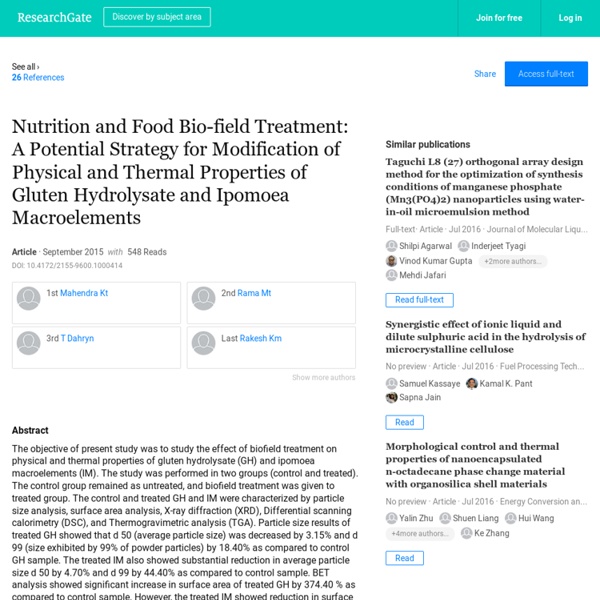Zoom
Trash
Related:



FT-IR Analysis of Biofield Treated Tetracycline Description Objective: Chloramphenicol and tetracycline are broad-spectrum antibiotics and widely used against variety of microbial infections. Nowadays, several microbes have acquired resistance to chloramphenicol and tetracycline. The present study was aimed to evaluate the impact of biofield treatment for spectroscopic characterization of chloramphenicol and tetracycline using FT-IR and UV-Vis spectroscopy. Citation Information Trivedi MK, Patil S, Shettigar H, Bairwa K, Jana s, et al. (2015) Spectroscopic Characterization of Chloramphenicol and Tetracycline: an Impact of Biofield .
Gluten Hydrolysate & Ipomoea Macroelements Properties – Read more Abstract Streptococcus agalactiae group B (S. agalactiae gr. B) is widespread in nature mainly causes bacterial septicemia and neonatal meningitis. The current study was attempted to investigate the effect of biofield treatment on S. agalactiae gr. B with respect of antimicrobial sensitivity, biochemical reactions and bio typing. S. agalactiae gr. Citation Information Mahendra Kumar Trivedi.
Biofield | Impact on Gluten Hydrolysate and Ipomoea Macroelements Open Access Research Article Analytical & Bioanalytical Techniques o u r n a l f y t i c e h q s Trivedi et al., J Anal Bioanal Tech 2015, 6:5 Volume 6 • Issue 5 • 1000265 J Anal Bioanal Tech ISSN: 2155-9872 JABT, an open access journal Keywords: Disulram; Nicotinic acid; Bioeld treatment; Fourier transform infrared spectroscopy; Ultraviolet spectroscopy Introduction Disulram [bis(diethylthiocarbamoyl)disulphide] is an antabuse drug, being used clinically as an aid to the treatment of chronic alcoholism. Administration to treat the alcohol addiction [1]. transforms into acetaldehyde by alcohol dehydrogenase enzyme, which further oxidized to acetic acid by acetaldehyde dehydrogenase (ADH) enzyme [2]. concentration of acetaldehyde increases and causes an unpleasant eect, thus increase the patient's motivation to remain abstinent [3]. addition to this, disulram is reported for protozoacidal eect in vitro study [4,5]. B3) that has cholesterol lowering activity. [7]. [10].
Modification of Gluten Hydrolysate & Ipomoea Macroelements Properties Title: Spectroscopic Characterization of Disulfiram and Nicotinic Acid after Biofield Treatment Publication: Analytical & Bioanalytical J Techniques Select license: Creative Commons Attributions-NonCommercial-ShareAlike Updated: November 19th, 2016 Abstract: Disulfiram is being used clinically as an aid in chronic alcoholism, while nicotinic acid is one of a B-complex vitamin that has cholesterol lowering activity. UV spectrum of control and biofield treated disulfiram showed similar pattern of UV spectra. Over all, the FT-IR and UV spectroscopy results suggest an impact of biofield treatment on the force constant, bond strength, and dipole moments of treated drugs such as disulfiram and nicotinic acid that could led to change in their chemical stability as compared to control.
Alteration in Thermal Properties of Ipomoea Macroelements Volume 5 • Issue 5 • 1000414 J Nutr Food Sci ISSN: 2155-9600 JNFS, an open access journal Open Access Research Article Nutrition and Food Sciences o u r n a l f t i d c e s Mahendra et al., J Nutr Food Sci 2015, 5:5 *Corresponding author: Snehasis J, Trivedi Science Research Laboratory Pvt. Bhopal- 462026, Madhya Pradesh, India, Tel: +91-755-6660006; E-mail: publication@trivedisrl.com Received August 06, 2015; Accepted September 21, 2015; Published September Citation: Mahendra KT, Rama MT, Alice B, Dahryn T, Gopal N, et al. (2015) Bio- eld Treatment: A Potential Strategy for Modication of Physical and Thermal Properties of Gluten Hydrolysate and Ipomoea Macroelements. 414. doi:10.4172/2155-9600.1000414 Copyright: © 2015 Mahendra KT, et al. under the terms of the Creative Commons Attribution License, which permits unrestricted use, distribution, and reproduction in any medium, provided the original author and source are credited. 2Trivedi Science Research Laboratory Pvt.
Spectroscopic Characterization of Disulfiram & Nicotinic Acid - Study more Description Disulfiram is being used clinically as an aid in chronic alcoholism, while nicotinic acid is one of a B-complex vitamin that has cholesterol lowering activity. The aim of present study was to investigate the impact of biofield treatment on spectral properties of disulfiram and nicotinic acid. Citation Information Mahendra Kumar Trivedi. Characteristic of Shigella sonnei after Biofield Treatment Abstract Shigella sonnei (S. sonnei) is a non-motile, rod shape, clinically significant, Gram-negative bacterium. It is commonly associated with dysentery (shigellosis). Recently, resistance to third and fourth generation cephalosporins and fluoroquinolones has been reported in S. sonnei. In the present study, we assessed the effect of biofield treatment on phenotyping and genotyping characteristic of S. sonnei (ATCC 9290). The lyophilized samples of S. sonnei were divided in three groups (G): G-I (control, revived), G-II (treatment, revived), and G-III (treatment, lyophilized). Tables at a glance Figures at a glance
Mahendra Kumar Trivedi | Journal of Microbial & Biochemical Technology Abstract Streptococcus agalactiae group B (S. agalactiae gr. B) is widespread in nature mainly causes bacterial septicemia and neonatal meningitis. Evaluation of Physical Properties of Indole o u r n a l f v i m e t y c h s Environmental Analytical Chemistry Mahendra Kumar et al., J Environ Anal Chem 2015, 2:4 Research article Open Access Volume 2 • Issue 4 • 1000152 J Environ Anal Chem ISSN: 2380-2391 JREAC, an open access journal Keywords: Indole; X-ray diraction; ermal analysis; Fourier transform infrared spectroscopy; UV-Vis spectroscopy Abbreviations XRD: X-ray diraction; DSC: Dierential scanning calorimetry; TGA: ermogravimetric analysis; DTA: Dierential thermal analyzer; DTG: Derivative thermogravimetry; FT-IR: Fourier transform infrared; UV-Vis: Ultraviolet-visible Introduction e theoretical basis of medicinal chemistry has become much more sophisticated, but is naive to suppose that the discovery of drugs is merely a matter of structure-activity relationships. compound which is parent substance for a large number of important molecules occurring in nature [1]. important class of therapeutic molecules which can replace many syndrome. progression [7].